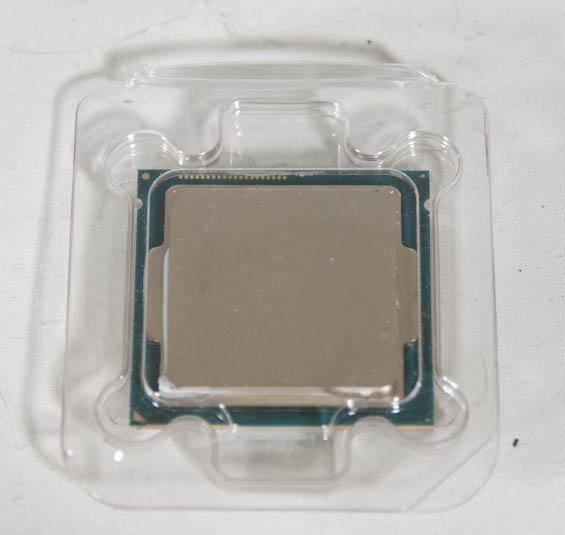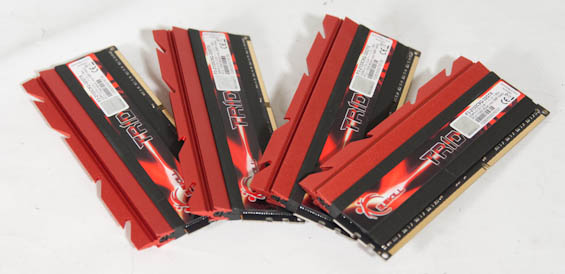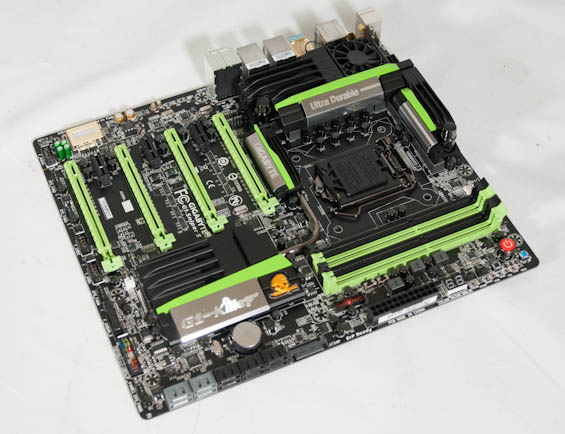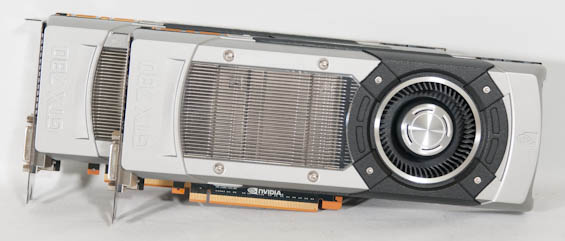The Neophyte's Custom Liquid Cooling Guide: How To, Why To, What To Expect
by Dustin Sklavos on September 30, 2013 12:01 AM ESTComponent selection for this build was tricky, but not overly so. If you're going to engage in an undertaking like this, you really do want to pick the most ideal hardware you can. Thankfully we had a few vendors willing to step up and donate some very high quality kit to this build.
Intel Core i7-4770K Processor

For our CPU we went with Intel's shiny new Haswell architecture in the form of the Core i7-4770K. This quad-core, hyper-threaded chip runs at a nominal 3.5GHz clock with a maximum turbo boost of 3.9GHz on a single core, and is one of Intel's first chips to feature an integrated VRM. Intel's 22nm chips seem to have been largely thermally limited, making the newest member of the family a compelling choice to be the center of a watercooling build. You do always run the risk of getting a dud CPU that simply doesn't want to run at a high clock speed without an unrealistic amount of voltage, though. Note that ours is a retail chip and not an Engineering Sample, so it's subject to the same potential limitations as any CPU you might pick up off the shelf.
Our thanks to CyberPowerPC for graciously donating this processor.
G.Skill Trident X 32GB (4x8GB) DDR3-2133 RAM

Our resident motherboard reviewer and overclocking expert, the good Dr. Ian Cutress, recommended we go with G.Skill for this build, and G.Skill was happy to oblige with a respectable kit of fast DDR3. This kit runs at a nominal 1600MHz, but features an XMP profile that sets it to run at 2133MHz with a CAS Latency of 9 at 1.6V. I'm not an aggressive memory overclocker, which makes the ready-out-of-the-box 2133MHz settings an easy way to score a little extra performance.
Our thanks to G.Skill for providing this memory.
Gigabyte G1.Sniper 5 Z87 Motherboard

I remain of the opinion that the Z87 chipset is arguably the most compelling part of Haswell, and Gigabyte's high end gaming offering hammers that home. The G1.Sniper 5 features a PLX switch enabling full PCIe 3.0 x16 lanes for each of two video cards, or PCIe 3.0 x8 for up to four. Alongside that are an additional four SATA 6Gbps ports to go along with the six that come with the Z87 chipset, dual gigabit ethernet NICs with one provided by Intel and the other courtesy of Killer Networks, and Creative Sound Core3D with a user upgradeable OP-AMP. There's even an 802.11n dual-band PCIe x1 wireless network adapter bundled with the motherboard.
But what sells this board for our purposes is that it includes not only active cooling on the motherboard's 16-phase power circuitry, but a liquid cooling path built in. There are barbs on both ends of the heatsink that allow you to include the power circuitry in your watercooling loop.
Our thanks to Gigabyte for providing this motherboard.
Dual NVIDIA GeForce GTX 780 Graphics Cards

With AMD currently still having issues with multi-GPU surround performance, we were left going to NVIDIA for a pair of high end graphics cards. Two GeForce GTX 770s would've been stellar on their own, but the 780 is getting a healthy reputation as being a decent overclocker in addition to just being a tremendously powerful card on its own. 7.1 billion transistors and 2,304 CUDA cores are nothing to sneeze at, and the 384-bit memory bus connected to 3GB of GDDR5 running at 6GHz stock ensures that beefy engine stays fed.
The biggest shame about using these reference 780s is actually having to remove their stock coolers. NVIDIA did a fantastic job engineering these shrouds, which are both very beautiful and very efficient.
Our thanks to NVIDIA for providing this pair of graphics cards.










106 Comments
View All Comments
Razorbak86 - Wednesday, October 2, 2013 - link
No problem. I'm pretty familiar with the voltage range, so I understood what you meant. I have a de-lidded 3770K OCed to 4.8 Ghz (offset) under water, and my voltage maxes out at 1.40V at load.Gigaplex - Monday, September 30, 2013 - link
The power/temp/sound results aren't particularly useful without a comparison of OC air vs OC liquid at the same OC levels. We can't tell if the CPU is hotter on liquid vs air due to higher voltages or the GPUs heating the liquid.prophet001 - Monday, September 30, 2013 - link
I thought this too. It would be nice to see metrics for identical OC settings on air and liquid. Seems like that would give more of an indication about how the cooling setup itself is performing.The Von Matrices - Monday, September 30, 2013 - link
I enjoyed reading your article. I have owned a custom loop for three years, and after recently upgrading to Haswell, I can say that my overclocking experience mirrors yours. There is just no advantage to using a custom liquid cooling system versus a good air cooler or closed-loop liquid cooling system.I have also had the same experience with PWM splitters, and I think the blame comes down to the splitter itself. The splitter I have (it looks very similar to the one you tested) doesn't have the pins fitting very tightly in their connectors. Frequently, inserting the female connector into the male socket will result in the pins of one or the other pushing themselves out of the connector instead of mating with the other side, and you have to push the pins (or wires if the pins are just slightly out) back into the connector in order to establish the electrical connection.
Two note as well is that are is worth mentioning: First, all video card full cover water blocks are designed with a particular PCB layout in mind, usually the reference PCB, so you have to be very careful which video cards you buy since they are not all compatible with the full cover blocks available. For example, for about the past six months there have been no more reference design AMD HD 7970s available on the market, so if you wanted to water cool the new 7970 you bought then you were out of luck (unless you wanted a MSI lightning, which one or two manufacturers make water blocks for). Second, while clear tubing looks great at first, it usually does not age well and begins to either turn yellowish or show water cooling fluid as it gradually gets dirtier over time. i would recommend solid color tubing if you want a system to look good with minimal maintenance.
The biggest issue with this article is that you never stated the costs of the water cooling components. The system you built I estimate has about $800-$1000 in water cooling components. It is important to note that the system does not have to be that expensive, particularly if you're not especially concerned with aesthetics. Barbs cost about half the price of compression connectors, and if you have 10 of them in the system that's about $100 saved right there. If you frequently upgrade graphics cards, you can use core-only water blocks and separate VRM and memory heatsinks. The initial cost is about the same as a full cover water block (~$120 for a good full-cover block versus $80 for a MCW82 + $40 for the VRM/RAM heatsink plate) but every time you replace the graphics card you only have to replace a $40 VRM/RAM heatsink plate instead of a $120 full cover water block. And you can eliminate all the quick disconnect fittings for another $80 savings.
I appreciate you documenting your experience!
DanNeely - Monday, September 30, 2013 - link
Unfortunately Swiftech has stopped selling monolithic plates for vram/vrm cooling on nVidia cards (allegedly due to their deal to make OEM watercoolers for eVGA). They still sell them for AMD cards; but on the nVidia front you're back to taping/gluing individual sinks onto each component.r3loaded - Monday, September 30, 2013 - link
I enjoyed reading this article, but I'd add that you'll see a huge drop in CPU temperatures (like, 20 degrees) if you're able to delid your 4770K and apply a good quality paste under the heatspreader. It's risky but worth it if you're careful.If only Intel hadn't decided to cheap out and abandon soldered heatspreaders as on Sandy Bridge and earlier.
kasakka - Monday, September 30, 2013 - link
Those load temps seem awfully high for the CPU. I can't help but think that maybe the CPU waterblock isn't properly mounted, has too much or too little TIM between it etc. Back when I was overclocking a watercooled C2Q 9550 the idle and load temps didn't change much and were around 40-50 degrees. Surely the current Intels would provide better temperatures?I stopped watercooling mainly because it would've been expensive to upgrade all the blocks when I went to Ivy Bridge. Turns out there is barely any noise difference between the water cooling and today's best air coolers, meaning I'm very happy with the near-silent setup I have now (3570K @ 4.5 GHz, Phanteks PH-TC14PE, Asus GTX660Ti w/ stock cooler) so purely from a noise level point of view water cooling isn't necessary anymore.
Jackie60 - Monday, September 30, 2013 - link
Well that was a very informative monumental waste of time and effort and would have been money too if it wasn't for Anandtech. This tells me don't even ever think about water cooling unless in a small prison cell for a long time.Death666Angel - Monday, September 30, 2013 - link
I'm glad you finally tackled custom water cooling in an article here on Anandtech! :D And for the first one, it wasn't half bad.There are a few things I would add though. It is highly unlikely in my experience that someone investing the time and money into a custom water cooling rig would not delid the CPU or use a IVB-E CPU. That should help increase OC headroom quite a bit and bring down temperatures. That doesn't mean that it can't be done with air cooling, but since that is infinitely easier to do, fewer people would invest the time/money to delid a high price CPU or get a high price platform like IVB-E.
But then again, watercooling just for the CPU has been dead since we stopped having 100+W CPUs. If you ask in any WC forum whether to custom cool the CPU, you will always get the response "It's not worth it just for that".
I also think that people have a wrong idea about custom WC. If you are not interested in the challenge it poses, then it isn't for you. The benefits (quieter running while providing better performance) are there, but they aren't great enough to change from air cooling if you don't enjoy the risk and the building and selection process.
If you plot a chart with performance/noise ratio, the water cooling rig can always be better than any air cooling that is available. It can also run components cooler at the same overclock, which increases their potential life span. However, these things come at a steep cost and may not be as necessary for many.
But it is very nice to have my AMD 7970 run at 1250/1650 at ~44°C and barely have any high noise than in idle. :D
Gigaplex - Monday, September 30, 2013 - link
IVB-E are 100+W CPUs.